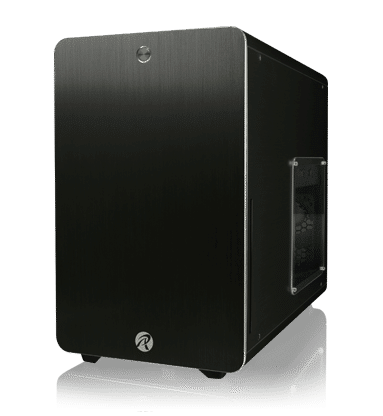
The Raijintek Styx is a housing for Micro-ATX systems, which not only wants to shine with compactness, but also optics. And although the Styx has compact dimensions, there’s plenty of room in the case.
Like every case, the Styx comes in a brown cardboard box. The housing is secured by two styrofoam elements. Included in the delivery is a short manual, which is actually only important if the number of hard disks to be fully exploited. Inside the housing is the standard mounting material such as screws.
After unpacking, the high quality of the housing is immediately noticeable. Our test object comes in the colour black, but there are also the colours silver, red, green, gold, blue and white. This means that no wishes remain unfulfilled, even with colour-coordinated systems. The housings are also optionally available with a built-in viewing window.
Basically, the Raijintek Styx consists of two different materials. The basic frame is made of steel and the front, lid and side walls are made of aluminium panels. The brushed aluminium makes the case particularly high-quality. Although the Styx only has dimensions of 210 x 335 x 360 millimeters (W x H x D), a surprising amount should fit into the case. In addition to a large CPU cooler, a large graphics card, two 3.5-inch HDDs and two 2.5-inch SSDs/HDDs should also be able to get their place. There’s even room for a radiator for water cooling. And even if the housing is directed at Micro-ATX systems, Mini-ITX boards can of course be installed.
Technical Data
| Dimensions | 210 x 335 x 360 mm (W x H x D) |
|---|---|
| Weight | 3,8 Kilogramm |
| Form factor | Micro-ATX, Mini-ITX |
| Material | steel, aluminium |
| Max. CPU cooler height | 180 mm |
| Max. Extension card length | 280 mm |
| Front connections | 2x USB 3.0, audio ports |
| Fans | Lid: 2x 140 mm (optional) Back: 1x 120 millimeter (pre-installed) Floor: 1x 120 millimeter (optional) |
| Drives | 3x 3.5 inch + 2x 2.5 inch or 1x 3.5 inch + 4x 2.5 inch |
| Price | 89,90 Euro |
The interior is kept simple in addition to the general design. Why should you trumpet up here with fancy colours and a lot of bells and whistles? The design does without many extras and focuses on simplicity. No playful extras but elegance due to the brushed aluminium and the rounded edges. The front and the side parts are completely smooth and come along at least in the simple version without side windows. Our version provides a small window with a view of the components. Only in the lid there is an opening which is covered with mesh. Of course, the space is intended for radiators or fans.
The I/O panel with the usual audio bushes and two USB 3.0 ports is still located in the front area of the cover. The power button is located in the middle of the upper part of the front.
Immediately during the assembly it is noticeable: The pages cannot be opened as usual. Four screws on each side must be removed from the side panels. Therefore, opening the case takes longer than usual and you can’t get around a screwdriver. As already mentioned, the interior and the rest of the Raijintek Styx is kept simple. It is completely in black and the construction is inverted. The mainboard is not located behind the left but the right side panel and is also installed upside down. This is not the last advantage of water cooling. The pump for this is then on the lower side. Should a leak occur, at least there are no graphics cards or other devices in the way. The power supply unit is even installed directly behind the front and connected via an additional cable. Only then can the computer be supplied with power on the back as usual. In addition, a drive can be mounted behind the front panel.
In itself, the Styx offers space for a total of five drives. It is important that the assembly cannot be carried out without tools. In addition to the 5.2-inch slimline drive, a maximum of three 3.5-inch data carriers can be installed. The removable cover in the interior offers space for two 2.5 or 3.5 inch data carriers. Behind the left side wall there is storage space for two 2.5 inch drives. However, a small format is important here. Finally, another 2.5 or 3.5 inch drive may be mounted on the floor. The supplied rubber rings serve as a decoupled contact surface.
To supply the components with fresh air, a 120 mm fan is pre-assembled in the Raijintek Styx. To suck the fresh air out of the housing, it is located on the back. Optionally, two 120 mm fans or a 240 mm radiator can be installed under the lid, and a further 120 mm fan can be installed on the base. The mesh grille embedded in the lid is also easy to remove for cleaning or fan installation. Further features are not included.
On the back side it is also noticeable that five slots are offered for expansion cards and that with this size. To hide the screws, a plastic cover is attached.
The workmanship of Raijintek Styx is reasonable for the price. In general, the case makes a stable impression and the brushed finish of the sheet metal is flawless. There is also nothing to criticize about the strength of the side panels. The image is only disturbed by the I/O panel.
Assembly
Due to the fact that Raijintek consistently relies on screws and that there is no getting around tools, assembly takes more time than usual. There are no problems in terms of volume, as there is enough space for all parts. The Noctua NH-C14S, with a height of 142 millimetres and a width of 140 millimetres, which we installed on a trial basis, fits perfectly into the case. Even with the length of 163 millimeters of the radiator there were no problems. After all, at 180 millimetres the Styx also offers enough space for high tower coolers. The graphics card we installed is relatively short and fits without problems. Raijintek even offers 280 millimetres of space for current high-end cards, which are very long in reference design.
On the backside of the mainboard tray we mount two 2.5 inch drives in the holders provided. The brackets can either be unscrewed before and later screwed on again with the drive mounted, or the data carrier can be mounted on the bracket before installing the mainboard. In the latter case, however, the rubber rings are not used, which doesn’t matter with an SSD. Two more 3.5 inch drives are attached to the front panel. Unfortunately, this must be dismantled before, since the hard disks point into the inside of the case.
The power supply unit is installed vertically behind the front. Last, of course, so that the cables do not interfere with the previous steps. After the assembly it is noticeable that a modular power supply would have been much more helpful. The unused cables are stored in the main chamber above the power supply anyway, but still require a lot of space. A larger distance between tray and sidewall would have been perfect. Unused cables could have simply been hidden behind it – not only for the optics.
Due to a missing test system we provide you with values from our private use. In the first test run, only the pre-installed 120 millimeter fan and a large CPU cooler were used. With Prime95 the limits of what was possible were already reached and the temperature was around 70° Celsius. In idle mode, the average temperature was around 32°. The GPU delivered a value of about 75° C.
Conclusion
The Raijintek Styx is a very solid case. By the combination of the simple design and the high-quality covering from brushed aluminum, the housing collects already at the beginning of the orderly sympathy points. Raijintek plays especially the colour selection into the cards.
The Styx also has a convincing interior. Despite the small size, components can still be easily removed and installed. A high CPU cooler (up to 180 millimeters) and long gaming graphics cards (up to 280 millimeters) are no problem for the case. Especially the possible number of drives pleases. You can decide for yourself whether you want to use large or small hard disks. And even if you use 3.5 inch HDDs, there’s still room for up to two SSDs on the back of the mainboard tray. If you still rely on CDs or Blu-Rays nowadays, you can also install an optical drive on request. Sufficient cooling capacity can also be provided. The supplied fan (120 millimeters) doesn’t provide an adequate airflow when the case is full, but it can be supported by installing additional fans.
The assembly of the components is somewhat more time-consuming due to the consistent use of screws and the necessary use of tools, but the overall picture is only slightly reduced as a result. What matters a little more is the space between the side wall and the tray, which almost requires a modular power supply. The power supply cables cannot be properly stowed or at least not in such a way that the cooling properties are not affected.
In short, the Raijintek Styx offers a lot of space, a great look and high-quality workmanship. There are deductions for the cooling capacity in the factory condition and the consistent use of screws. A frequent component change then unfortunately becomes a torture. The price of 89 Euro may be a bit high, but you get a solid case with a high quality fairing.
Raijintek Styx
Workmanship
Design
Features
Cooling
Small housing - lots of space
The Raijintek case offers high-quality workmanship and a lot of space, but also a few shortcomings.








